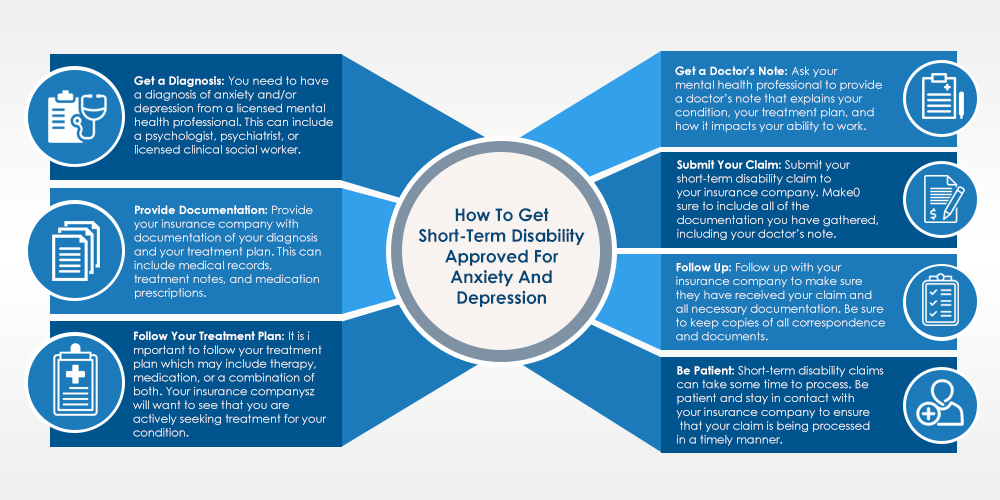If you are experiencing anxiety and depression, and it is impacting your ability to work, you may be eligible for short-term disability benefits. Here are some steps to follow to get short-term disability approved for anxiety and depression:
- Get a Diagnosis: You need to have a diagnosis of anxiety and/or depression from a licensed mental health professional. This can include a psychologist, psychiatrist, or licensed clinical social worker.
- Provide Documentation: Provide your insurance company with documentation of your diagnosis and your treatment plan. This can include medical records, treatment notes, and medication prescriptions.
- Follow Your Treatment Plan: It is important to follow your treatment plan, which may include therapy, medication, or a combination of both. Your insurance company will want to see that you are actively seeking treatment for your condition.
- Get a Doctor’s Note: Ask your mental health professional to provide a doctor’s note that explains your condition, your treatment plan, and how it impacts your ability to work.
- Submit Your Claim: Submit your short-term disability claim to your insurance company. Make sure to include all of the documentation you have gathered, including your doctor’s note.
- Follow Up: Follow up with your insurance company to make sure they have received your claim and all necessary documentation. Be sure to keep copies of all correspondence and documents.
- Be Patient: Short-term disability claims can take some time to process. Be patient and stay in contact with your insurance company to ensure that your claim is being processed in a timely manner.
Remember, the requirements for getting short-term disability approved for anxiety and depression may vary depending on your insurance policy and the state you live in. It’s important to review your policy and consult with your insurance company or an attorney if you have any questions or concerns.

What Is Anxiety?
Anxiety is a normal human response to stress or danger. It is a feeling of unease, such as worry or fear, that can be mild or severe. Anxiety can be a helpful response, as it can help us stay alert and focused in potentially dangerous situations, but it can also become overwhelming and interfere with daily life if it is persistent or severe.
Anxiety disorders are a group of mental health conditions characterized by excessive and persistent feelings of anxiety or fear. These disorders can include generalized anxiety disorder, panic disorder, social anxiety disorder, and specific phobias. Anxiety disorders can cause a wide range of symptoms, including restlessness, irritability, difficulty concentrating, sleep disturbances, and physical symptoms such as sweating, trembling, and rapid heartbeat.
Anxiety can be caused by a variety of factors, including genetics, brain chemistry, life experiences, and ongoing stress. Treatment for anxiety disorders may include therapy, medication, or a combination of both. It’s important to seek help from a mental health professional if you are experiencing persistent or severe anxiety symptoms that interfere with your daily life.
What Is Depression?
Depression is a mental health disorder that is characterized by persistent feelings of sadness, hopelessness, and lack of interest or pleasure in activities. It can cause a wide range of emotional and physical symptoms that can interfere with daily life.
Symptoms of depression can include feelings of sadness, worthlessness, or guilt, loss of interest in activities, changes in appetite or sleep patterns, fatigue, difficulty concentrating, and thoughts of self-harm or suicide.
Depression can be caused by a variety of factors, including genetics, brain chemistry, life experiences, and ongoing stress. It can be a result of a major life event, such as the loss of a loved one, or it can develop gradually over time.
Treatment for depression may include therapy, medication, or a combination of both. It’s important to seek help from a mental health professional if you are experiencing persistent or severe depression symptoms that interfere with your daily life. With proper treatment, most people with depression can recover and lead fulfilling lives.
How To File A Claim For Short-Term Disability
Filing a claim for short-term disability can be a complex process, but with the right steps, you can make the process easier. Here are some general steps to follow when filing a claim for short-term disability:
- Review Your Policy: The first step is to review your short-term disability policy to understand the coverage and eligibility requirements. You should also check if there is a waiting period before the benefits kick in and how long the benefits will last.
- Notify Your Employer: Notify your employer as soon as possible that you need to file a claim for short-term disability. Your employer will provide you with the necessary forms to start the process.
- Complete the Forms: Fill out the required forms carefully and provide all the necessary information. Make sure to include your contact information, your diagnosis, and the date your condition started. You will also need to provide documentation of your condition, such as medical records, doctor’s notes, and test results.
- Submit Your Claim: Once you have completed the forms and gathered all the required documentation, submit your claim to the insurance company. Make sure to keep a copy of everything you submit for your records.
- Follow Up: Follow up with the insurance company to make sure they have received your claim and all necessary documentation. You may need to provide additional information or answer questions from the insurance company.
- Wait for a Decision: The insurance company will review your claim and make a decision on whether to approve or deny your claim. This process may take several weeks, so be patient.
- Receive Benefits: If your claim is approved, you will receive your short-term disability benefits. The benefits will be paid according to the terms of your policy and the length of time you are eligible to receive benefits.
Remember, the process for filing a claim for short-term disability can vary depending on your employer’s policy and the insurance company providing the coverage. Be sure to review your policy and follow the specific instructions provided by your employer and the insurance company to ensure a smooth process.


Leave A Comment